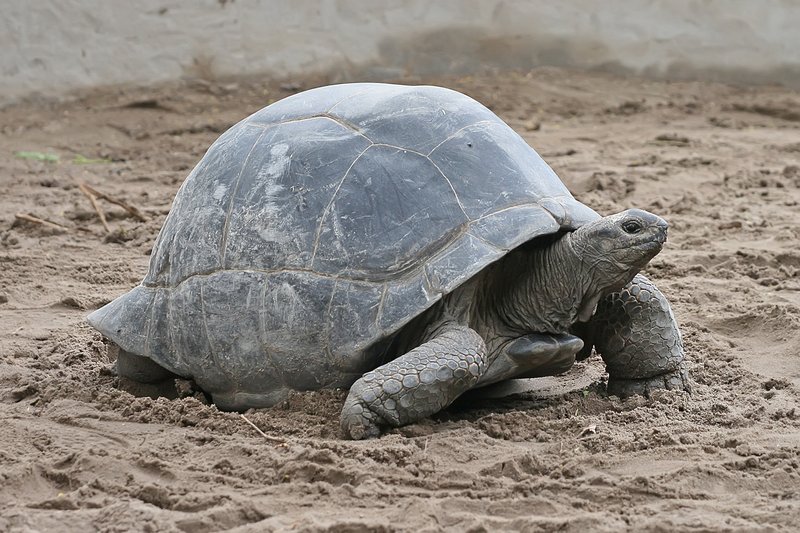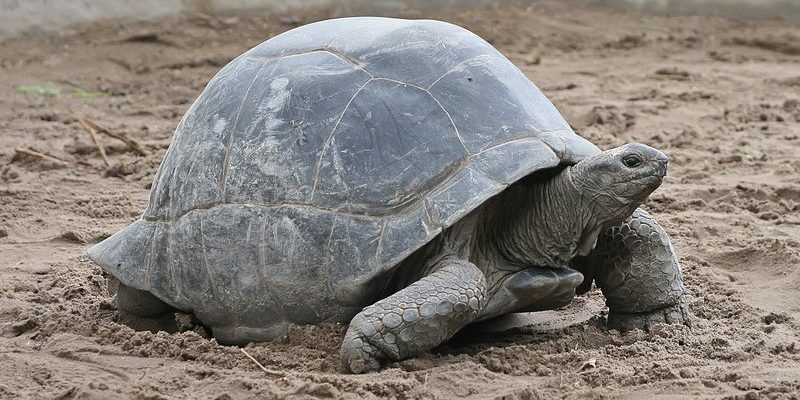
Native to the Aldabra Atoll in the Seychelles, these tortoises are more than just a pretty shell. They play a crucial role in their ecosystem and have a fascinating biological history. Over the next few sections, we’ll explore some incredible facts about these tortoises that will surely spark your curiosity and appreciation for one of nature’s most extraordinary creatures.
1. They Can Weigh Over 500 Pounds!
The sheer size of the Aldabra giant tortoise is staggering. These tortoises can reach weights of over 500 pounds, making them one of the heaviest tortoise species on the planet. To visualize this, think of a large dog, but with a shell that’s not just a fashion statement—it’s a fortress! Some exceptional individuals have been recorded weighing up to 600 pounds or more, all while gracefully lumbering around their island home.
These hefty creatures have a slow metabolism and can go without food for several months. This ability to adapt to their environment is a remarkable survival tactic, especially in areas where food isn’t always plentiful. Just like how you might save leftovers for later, these tortoises store energy in their fat reserves, allowing them to thrive even when resources are limited.
2. They Have a Remarkably Long Lifespan
Aldabra giant tortoises are known for their astonishing longevity, living up to 150 years or more. That’s right! If you meet one, it could very well have been alive during the Victorian era! Many people wonder what their secret is. It seems that their slow-paced lifestyle plays a significant role, allowing them to lead stress-free lives and avoid the hustle and bustle we humans often experience.
Their aging process is fascinating to study. Unlike other animals that show clear signs of aging, Aldabra tortoises maintain a youthful appearance for most of their lives. Their shells grow in size and develop unique patterns, much like the rings of a tree, marking the passage of time. So the next time you see one, just think about how many stories it could tell if it could speak!
3. They’re Herbivores with Unique Eating Habits
Aldabra giant tortoises are strict herbivores, munching on a diet primarily made up of grasses, leaves, and fruits. Here’s the thing: they have special adaptations that allow them to thrive on a plant-based diet. For instance, their strong jaws help them graze effectively on tough vegetation. It’s like having nature’s very own lawnmower!
These tortoises play an essential role in their ecosystem by helping to disperse seeds. As they eat fruits and berries, they inadvertently spread the seeds through their droppings. This natural process helps to maintain the plant population on the islands, showcasing just how interconnected nature can be. Every meal they have contributes to the health of their environment!
4. Unique Shell Characteristics
If you’ve ever looked closely at a tortoise shell, you know it’s not just a hard covering; it’s a work of art! The Aldabra giant tortoise’s shell is dome-shaped, providing them with protection and stability. Their shells can grow to about 4 feet in length, and just like snowflakes, no two shells are the same. Each one has distinct patterns and colors that can change as they grow.
This structure plays a vital role in their survival. The shell not only protects them from predators but also helps them regulate their body temperature. On hot days, they can soak up the sun’s rays, and when it gets cooler, they might find a shady spot under a tree. So, their shell is like a protective umbrella that’s always ready to adapt to the weather!
5. Habitat and Conservation Status
The Aldabra Atoll, where these majestic tortoises reside, is a UNESCO World Heritage site. This location is crucial for the survival of the Aldabra giant tortoise, as it’s one of the few places in the world where they can live wild and free. The island is relatively untouched by human activity, which is a blessing for these creatures.
Unfortunately, Aldabra giant tortoises face threats from habitat loss and climate change. Conservation efforts are in place to protect their natural habitat and ensure they continue to thrive. Organizations work diligently to monitor their populations and educate visitors about the importance of preserving these magnificent tortoises. It’s a reminder of how small actions can make a big difference in protecting our planet’s incredible biodiversity.
6. They Communicate in Unique Ways
You might think that tortoises are quiet creatures, but they have some interesting ways of communicating. Aldabra giant tortoises can produce various sounds, from grunts to hisses, especially during mating season. It’s fascinating to think about how these gentle giants express themselves through simple vocalizations.
In addition to sounds, they also use body language during interactions. For instance, if one tortoise feels threatened, it might retract its head into its shell or change its posture. This non-verbal conversation is crucial in their social dynamics, allowing them to navigate relationships within their groups. Just like us, they have their own way of saying “hello” or “back off!”
7. They Have Few Natural Predators
Due to their giant size and protective shells, Aldabra giant tortoises have very few natural predators. However, young tortoises are at risk from birds of prey, such as hawks. As they grow older and larger, their shells become a fortress that most animals can’t penetrate. It’s similar to how a big dog might feel safe in its home, knowing its size deters most threats.
However, despite their resilience, human activities can pose significant risks. Habitat destruction and poaching have historically threatened their populations. This situation highlights the importance of conservation and protecting their habitats against human encroachment, ensuring these gentle giants can thrive for generations to come.
8. They Have a Unique Reproductive Life Cycle
Aldabra giant tortoises have a remarkable reproductive life cycle. Mating generally occurs during the rainy season, and females can lay between 9 to 25 eggs at a time. Here’s the interesting part—after laying eggs, mothers will often bury them in the sand and leave them alone, trusting that nature will take care of the rest. It’s like planting seeds and letting them grow on their own!
The eggs incubate for several months before hatching. Once the baby tortoises emerge, they’re on their own. Their journey is fraught with challenges, but those that survive grow into the giants we admire. Learning about their reproductive habits gives us insight into the delicate balance of life in the wild and the importance of nurturing future generations.
9. They Contribute to Their Ecosystem
Aldabra giant tortoises are more than just fascinating creatures; they play a significant role in the ecosystem of the Aldabra Atoll. As herbivores, they help maintain the balance of plant life on the islands. By grazing, they control vegetation growth, which prevents certain plants from overtaking the ecosystem.
Additionally, their waste acts as fertilizer, enriching the soil and fostering plant growth. Each tortoise is like a gardener in its environment, making it a healthier place for various species. Understanding their role in ecology emphasizes the importance of preserving these incredible tortoises—not just for their sake but for the health of an entire ecosystem.
10. They Are Symbols of Conservation
The Aldabra giant tortoise has become a symbol of wildlife conservation efforts worldwide. Conservation programs aim to protect their habitat and educate people about the importance of preserving these unique animals. Just like a flag waving for a cause, these tortoises inspire efforts to conserve not just their species but many others facing similar threats.
Visitors to the Aldabra Atoll often leave with a newfound appreciation for these gentle giants, understanding that protecting them means safeguarding their home and all the life that depends on the islands. Seeing these tortoises in their natural habitat serves as a powerful reminder of what we stand to lose if we don’t prioritize conservation.
In conclusion, the Aldabra giant tortoise is a captivating creature with a remarkable story. As we’ve discovered, they are not just slow-moving reptiles but important members of their ecosystem and symbols of conservation efforts. By learning about their lives, we gain a greater appreciation for the complexities of nature and the importance of protecting our planet’s biodiversity. So the next time you think of these gentle giants, remember—they’re not just fascinating; they’re vital to the health of our world.

